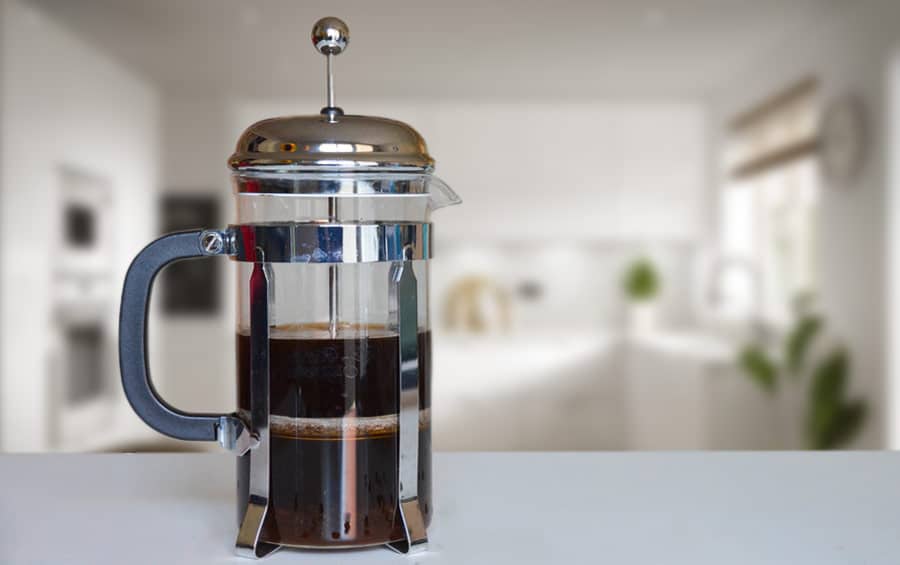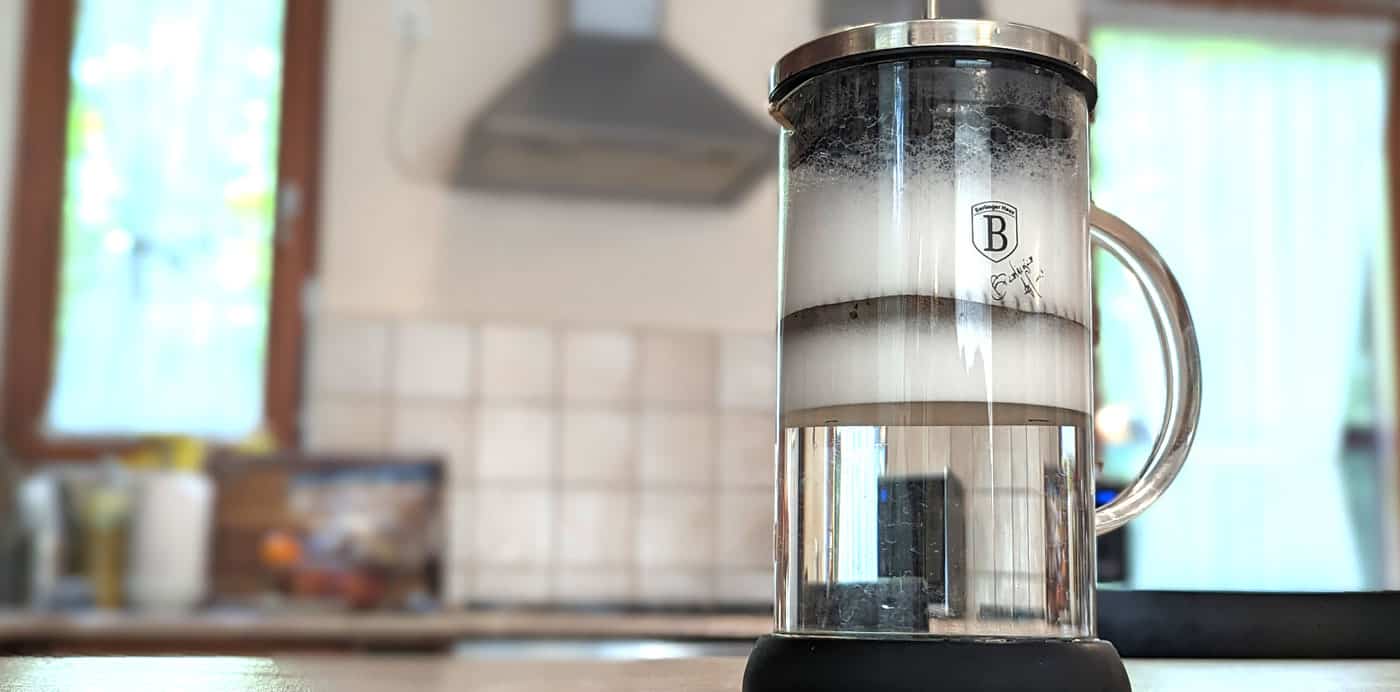4 Easy Ways to Clean a French Press: Quick, Easy, and Thorough Methods
I’ve been using a French press for brewing coffee for years now, and I know full well that maintaining its cleanliness is essential to making consistently delicious brews every time.
To help you keep your French press in tip-top shape, here’s a handy guide for you. In this article, I’ll discuss the different methods to keep your French press clean, from quick daily cleaning habits to thorough deep cleaning tricks.
How Often Should You Clean Your French Press?
I recommend giving your French press a quick clean after every use to prevent oil build-up and residue from accumulating over time. Also, if you don’t empty the use coffee grinds from your French press, mold will start growing on it, and that’s just yucky.
This quick clean is especially important if you’re using your French press frequently throughout the day or sharing it with others. It’ll only take a few minutes and will save you time and effort when it comes to deep cleaning in the future.
In addition to this per-use cleaning routine, I suggest deep cleaning your French press at least once a week. This involves disassembling all of the components and thoroughly washing them with soap and water. If you’d like an even deeper clean, try soaking everything in vinegar overnight before washing.
If you notice any mold growth on your French press, don’t wait until the weekly deep clean to address it. Mold can be harmful to consume and should be taken care of immediately.
Keeping up with regular cleaning routines will not only extend the life of your French press but also ensure that each cup of coffee is fresh and delicious.

What You’ll Need for Cleaning a French Press
Next up, make sure you have all of the necessary tools and materials. Here’s what you’ll need:
Equipment/Tools:
- Dish soap: used for cleaning and removing coffee oils from components.
- A sponge or brush (preferably with soft bristles): used to scrub the different components of the French press.
- Dishwasher (if applicable): an alternative method for daily cleaning.
- Measuring cup: used for the cleaning method with vinegar.
Materials:
- Hot water: used to rinse and clean the different components of French press.
- White vinegar (for deep cleaning method only): this acidic solution will help you remove build-up in hard-to-reach areas.
- Baking soda (for baking soda method only): an abrasive agent that aids in scrubbing away tough stains or residue.
One thing to note is that only certain French presses are dishwasher-safe, so be sure to check your specific model before attempting the daily cleaning method with a dishwasher.
It doesn’t take much to keep your French press clean and ready for use whenever you need to brew coffee. By having these simple materials on hand and taking time each day to give your French press a quick clean, you’ll be able to enjoy fresh-tasting coffee every time.
4 Methods to Clean Your French Press
There are different ways that you can explore to clean your French Press. Here are four methods to do it right:
Method 1: Quick and Easy Cleaning After Each Use
This first method is a quick and easy way for cleaning daily. This method is perfect for you if you use your French press frequently throughout the day or want to ensure that it’s clean before making a new batch of coffee.
Here’s how you can clean your French press daily:
1. Empty your French press and remove any coffee grounds left inside
- Empty the carafe to remove any leftovers from your brewing and discard them properly. Use a spatula or a long wooden stirring spoon to get most of the grinds out.
- Avoid this mistake I’m guilty of: dumping coffee grounds down the drain can cause blockages in the pipes.
2. Rinse the components with hot water
- Rinse each component under hot running water.
- Make sure you remove any remaining grinds or oils.
3. Add dishwashing liquid
- Add a few drops of dish soap into the carafe
4. Fill up the carafe with hot water 1/2 full
- Use hot water to fill up the carafe.
- You don’t want to go over the 1/2 mark, since the extra bubbles created by the plunging will quickly spill (or even shoot) out the spout. Trust me, I’ve been there.
5. Insert the plunger and plunge rapidly 5-10x
- Insert the plunger.
- Plunge down and up as many times as needed to make the water foamy.
- This cleans the carafe AND the plunger very quickly.
6. Rinse well
- Pour out the soapy water.
- Rinse each part thoroughly under hot running water until there’s no more soap residue left.
- You may need to repeat from step 3 if you have been neglecting your French press.
6. Let dry
- Let all of the components air dry on a towel or drying rack before reassembling.
This process should only take a couple of minutes but will make a big difference in keeping your French press fresh and ready for use.

Method 2: Daily Cleaning with a Dishwasher
If your French press is dishwasher-safe, this daily cleaning method might be the perfect solution for you. Here are the steps to cleaning your French press with a dishwasher:
1. Empty your French press
- Remove all leftover coffee grounds from the carafe and dispose of them properly.
2. Disassemble and rinse
- Separate all of the components including the plunger, filter, lid, and carafe.
- Rinse the main parts of any visible coffee grinds or oils.
3. Load the carafe into the dishwasher
- Place each component on the top rack of your dishwasher.
- Make sure they’re securely placed so nothing falls out during the washing process.
4. Run the dishwasher
- Add dishwashing detergent to your machine’s dispenser according to instructions.
- Run a normal cycle.
5. Dry and reassemble
- Once done, let it dry before reassembling.
While this method doesn’t require as much manual labor as others, I find the first manual method the best.
Warning: Ensure that your French press is dishwasher-safe or this will damage the parts of your brewer.
Additionally, if there are any leftover coffee grinds stuck in hard-to-reach areas like filters or mesh screens, use a toothbrush or sponge brush to gently clean those spots before running through the dishwasher cycle.
Method 3: Deep Cleaning a French Press
Aside from daily cleaning, your French press also needs a more thorough cleaning every now and then. This should be done once a week or every other week, depending on how much brewing you’re doing with it. This method will require some extra steps but ultimately provide a cleaner coffee experience.
Assuming you’re starting with a clean French press as per Method 1, here’s how to deep clean your French press:
1. Empty the French press and rinse well
- Remove all leftover coffee grounds from the carafe
- Rinse each component under hot running water, making sure to remove any remaining grinds or oils.
2. Disassemble the components
- Separate all of the components including the plunger, filter, lid, and carafe.
3. Prepare your cleaning solution with vinegar
- In a bowl, mix equal parts of vinegar and hot water.
4. Soak the filter and plunger
- Leave both the filter and plunger into the mixture overnight.
- Make sure all areas are submerged. Wait a little bit more if your French press is dirtier.
5. Wash the carafe and lid
- Use dish soap on a sponge or brush to scrub down the carafe and lid until they look clean.
6. Rinse well and dry
- Carefully pour out the vinegar solution
- Rinse everything very thoroughly under hot running water before air-drying on a towel or drying rack.
That’s it. A little bit longer than daily cleaning methods but definitely worth it when keeping up with your French press maintenance routine. Make sure you’re doing this weekly deep clean regularly as it can help prevent buildup over time which may affect the taste quality of your brews.
Method 4: Cleaning a French Press with Baking Soda
If you’re looking for other cleaning alternatives, the baking soda method is another popular option. it may not be a good idea to use this with non-glass carafes though, as the baking soda solution we’ll prepare is abrasive.
Here are the steps to cleaning your French press with baking soda:
1. Prepare your cleaning solution
- Mix a small amount of water with about 1 tablespoon of baking soda. You want to make the baking soda pasty, so you can scrub with it in the next step.
2. Scrub the components with your mixture
- Use a sponge or brush to apply the mixture onto all components including the plunger, filter, lid, and carafe.
- Make sure you scrub gently so that you don’t want to damage any parts.
3. Rinse well and dry
- Rinse everything thoroughly under hot running water until there’s no more residue left from the solution.
- Let it air dry on a towel or drying rack before reassembling.
The abrasive properties of baking soda make it effective in removing tough stains or build-ups without damaging your press. However, this shouldn’t replace weekly deep cleans as baking soda doesn’t clean some hard-to-reach areas that vinegar does better. Click here for more cleaning solutions for your coffee maker.
Removing Mold from a French Press
Mold growth in your French press can be concerning and even harmful to consume if not dealt with properly. Here are steps to address this:
- Identify mold presence – Look for black spots or fuzzy patches on the different components of your French press, indicating that mold has begun forming.
- Give it a deep clean ASAP – Once you’ve confirmed that there is indeed mold in your French press, do a deep clean using the vinegar method.
- Prevent mold growth in the future – Always make sure to empty out coffee grounds and rinse off all components after every use, then let everything air dry instead of leaving moisture inside your machine as it will create bacteria build-up over time that might lead to mold formation.
Tips to Keep Your French Press Clean Longer
Now that we’ve covered the different cleaning methods for your French press, I’m sharing with you some tips to help keep it cleaner longer:
- Store the French press properly– Make sure to keep your French press in a dry and cool place away from moisture after every use.
- Regular maintenance – giving it daily quick cleans and weekly deep cleans will prevent any residue or buildup from accumulating over time.
- Avoiding common mistakes that lead to build-up and residue such as:
- Not cleaning frequently enough
- Allowing coffee grounds to sit inside the carafe before rinsing out
- Using soap with harsh chemicals which can damage components.
To avoid these issues, stick to a regular cleaning routine and only use mild dish soap when washing parts of your machine. With a clean French press, you can brew your favorite drinks from pure coffee to delicious recipes such as this Cafe Au Lait and chocolate coffee.
Frequently Asked Questions
Here are answers to some common questions about cleaning a French press:
Washing your French press after every use is my recommendation, but it’s not absolutely necessary. But as you now know, giving your French press a quick clean after each use will help keep it fresh and ready for next time.
Yes, this is often done to make cold brew using a French press. Just be sure to give it a proper cleaning after use.
Using a dishwasher requires the least effort for cleaning your French press, if it is applicable to your brewer according to the manufacturer.
I’ve only ever experienced a metallic taste in my coffee when it was made with a low-grade stainless steel French Press. If you’re using a decent model or brand, then this shouldn’t be an issue.
Summary
That might seem a lot to take in but once you’ve built the habit of properly cleaning your French press, it’s definitely worth it in the long run. This isn’t just to keep your brewer in tip-top shape, but it also maintains the optimal taste quality in your brews.
It only takes a few minutes of your time, but if that’s too much, you can look into drip coffee methods or the Aeropress method, the cleanup is quicker there.
Remember, prevention is better than cure. So before your French press gets any mold or other issues involving coffee grime or rancid odors, give it a good and consistent clean and it will reward you with a flavorful cup with all the coffee benefits.







